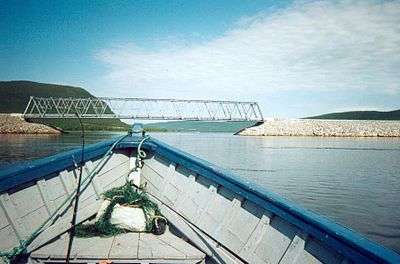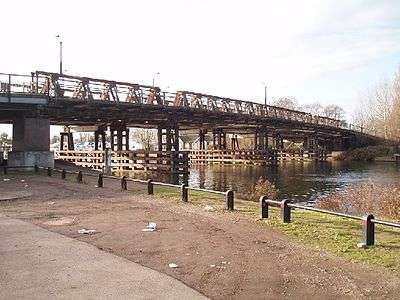Callender-Hamilton bridge
The Callender-Hamilton bridge is a modular portable pre-fabricated truss bridge. It is primarily designed for use as permanent civil bridging as well as for emergency bridge replacement and for construction by military engineering units. Assembling a Callender-Hamilton bridge takes much longer than the more familiar Bailey bridge as it is made up of individual lengths of galvanised steel bolted together with galvanised high-strength steel bolts, all of which require torque settings. It is stronger and simpler in design concept than the Bailey bridge.

History
The Callender-Hamilton bridge system was designed by the New Zealand civil engineer, A. M. Hamilton, and patented by him in 1935. The system is currently fabricated by Painter Brothers, Hereford, operating within the Balfour Beatty Power Networks Division[1] formerly British Insulated Callender's Cables.
Hamilton's bridge concept was inspired by his work between 1928 and 1932 as principal engineer on the 'Hamilton Road' through Iraqi Kurdistan. He described the building of this road in his book, Road Through Kurdistan: Travels in Northern Iraq, 1937. Hamilton became aware of the need for strong, adaptable bridges made from simple components that could easily be transported and erected in remote locations or on difficult terrain. Hamilton was awarded £4,000 in 1936 by the War Office for the use of his early bridges and the Royal Commission on Awards to Inventors awarded him £10,000 in 1954 for the partial breach of his patent by the design of the Bailey bridge.[2]
Design
The Callender-Hamilton bridge system is a prefabricated Panel/Floor Beam/Deck system designed to span bridging lengths ranging from 30 to 150 metres with road widths of one to three or more lanes. The design uses Warren trusses and is centred on a series of gusset plates that allow the direct attachment of the longitudinal, diagonal, vertical, and cross framing members. Centralised connection points increase the speed of construction and allow identical panels to be fabricated from identical members and then installed on site. An important feature is that all connections are bolted, so removing the need for onsite welding.
The bridge is usually built on falsework. A reinforced concrete deck is then superimposed on, and acts compositely with, the fabricated steel truss deck, thereby eliminating the use of scaffolding. A steel orthotropic deck, steel open grate deck or a timber deck are alternatives to a concrete deck. As with the Bailey bridge, an enhanced feature of the Callender-Hamilton bridge is that it can be assembled entirely on one side of a gap and with a removable launching nose added then be projected on rollers to the other side.[3]
All bridge elements are small enough to be transported by road and site operations can be carried out without skilled labour, special plant or heavy equipment. Because of the modular design, repairs are as structurally efficient as the original construction and at the end of service dismantled bridges can be reduced to initial components for reuse. Salvability is high due to the hot-dip galvanisation of each individual component.
Examples of Callender-Hamilton bridges in use

- Bridge No 194 in KZJ-BPQ Section, South Central Railway, India [4]
- Caparmesnil near St-Pierre-sur-Dives, Normandy [5]
- Cleenish Island Road County Fermanagh, Northern Ireland [6]
- Grand Falls - Province of Newfoundland and Labrador [7]
- Heusdensch Canal Netherlands [8]
- Langwathby Bridge, Cumbria [9]
- St. Lewis and Alexis Rivers, Province of Newfoundland and Labrador [3][7]
- Tal-y-Cafn type B10 bridge over the River Conwy [10]
- Two Fords Bridge Lydlinch, Dorset [11]
- Two Lane Bridge at St. Paul's Bay - Province of Newfoundland and Labrador [7]
- Vernon, Eure, Normandy,[12] between 1945 and 1955.
- Walton Bridge Fourth Bridge [13]
- Pont du Mandrare, Anosy, Madagascar [14] between 1958 and 2012.
- Kearsley pipe bridge, River Irwell, Kearsley, Bolton (washed away in floods February 2020)
- Axminster, Somerset - A temporary Callender-Hamilton bridge has been constructed over the River Axe adjacent to the M5 to facilitate construction works for the Hinkley C Nuclear Power Station power grid connection
See also
- Mabey Logistic Support Bridge - the modern day Bailey Bridge used by NATO countries.
- Medium Girder Bridge - a modern functional equivalent of the Bailey bridge.
- Military engineer
- Pontoon bridge - for another bridge type with mobile military application.
References
- "Company Profile". Painter Brothers. Retrieved 2013-06-13.
- "Bridge Claim By General "Used As Basis For Bailey Design"". The Times. 26 July 1955. p. 4 col E.
- Bridges on the Trans Labrador Highway
- "Archived copy" (PDF). Archived from the original (PDF) on 2011-09-02. Retrieved 2011-02-11.CS1 maint: archived copy as title (link)
- "Rechercher". Dday-overlord.forumactif.com. Retrieved 2013-06-13.
- "TNC On Tour Summer 2007 Page 29". Tuesdaynightclub.co.uk. 2007-07-19. Retrieved 2013-06-13.
- Archived June 27, 2009, at the Wayback Machine
- The Story of a Callender-Hamilton Bridge Demolished after 63 years
- "Cumbria - Places - Langwathby Bridge". BBC. 2008-04-28. Retrieved 2013-06-13.
- "Tal-y-Cafn Bridge in North Wales". Painter Brothers. Archived from the original on 2012-03-24. Retrieved 2013-06-13.
- Archived January 5, 2010, at the Wayback Machine
- "Walton Bridge - The fourth bridge". Archived from the original on 2009-12-05. Retrieved 2009-12-14.
- [https://www.youtube.com/watch?v=AP1YxMCiYEE Pont du Mandrare
External links
- 'Callender-Hamilton bridge handbook - highway bridges type B' by Gordon Douglas White-Parsons. Published 1952, British Insulated Callender's Construction Company ([London])